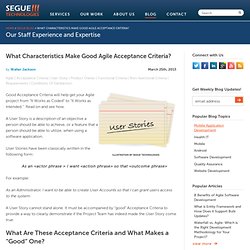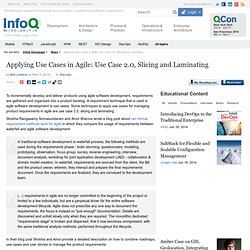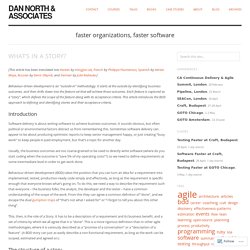

Segue Technologies - Custom Software Development, Professional Website Design, Information Technology. Good Acceptance Criteria will help get your Agile project from “It Works as Coded” to “It Works as Intended.”

Read on and see how. A User Story is a description of an objective a person should be able to achieve, or a feature that a person should be able to utilize, when using a software application. User Stories have been classically written in the following form: As an <actor phrase > I want <action phrase> so that <outcome phrase> For example: As an Administrator, I want to be able to create User Accounts so that I can grant users access to the system. A User Story cannot stand alone. What Are These Acceptance Criteria and What Makes a “Good” One? Microsoft Press defines Acceptance Criteria as “Conditions that a software product must satisfy to be accepted by a user, customer or other stakeholder.” These criteria define the boundaries and parameters of a User Story/feature and determine when a story is completed and working as expected. An Example. Applying Use Cases in Agile: Use Case 2.0, Slicing and Laminating. To incrementally develop and deliver products using agile software development, requirements are gathered and organized into a product backlog.

A requirement technique that is used in agile software development is use cases. Some techniques to apply use cases for managing product requirements in agile are use case 2.0, slicing and laminating. Shobha Rangasamy Somasundaram and Amol Sharma wrote a blog post about can formal requirement methods work for agile in which they compare the usage of requirements between waterfall and agile software development: In traditional software development or waterfall process, the following methods are used during the requirements phase - brain storming, questionnaire, modeling, prototyping, observation, focus group, survey, reverse engineering, interview, document analysis, workshop for joint application development (JAD) - collaboration & domain model creation.
Andy Hayward explored different requirement techniques in a series of blog post. Why I still use use cases. XP pretty much banned use cases, replacing them with the similar sounding “user stories” (see A user story is to a use case as a gazelle is to a gazebo (discussion: Re: A user story is to a use case as a gazelle is to a gazebo)}, and as a result agile zealots have been happy to dump use cases in the trash (along with their project managers, estimates, plans, and architectures).

Scrum did similar, using the “product backlog” instead of user stories. Yet as I go around projects, I keep running across organizations suffering from three particular, real, painful, and expensive problems: User stories and backlog items don’t give the designers a context to work from – when is the user doing this, and what is the context of their operation, what is their larger goal at this moment? Use cases are, indeed, heavier and more difficult than either user stories or backlog items, but they bring value for that extra weight. As not-Einstein said: “Make things as simple as possible, but no simpler.”
S. What’s in a Story? « DanNorth.net. [This article has been translated into Korean by HongJoo Lee, French by Philippe Poumaroux, Spanish by Adrian Moya, Russian by Denis Oleynik, and German by Julia Kadauke.]

Behaviour-driven development is an “outside-in” methodology. It starts at the outside by identifying business outcomes, and then drills down into the feature set that will achieve those outcomes. Each feature is captured as a “story”, which defines the scope of the feature along with its acceptance criteria. This article introduces the BDD approach to defining and identifying stories and their acceptance criteria.
Introduction Software delivery is about writing software to achieve business outcomes. Usually, the business outcomes are too coarse-grained to be used to directly write software (where do you start coding when the outcome is “save 5% of my operating costs”?) This, then, is the role of a Story. The structure of a story BDD provides a structure for a story. Telling the story The characteristics of a good story 1. User Stories Workshop For Agile Product Development.